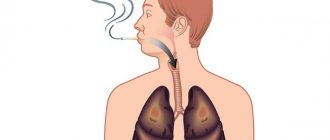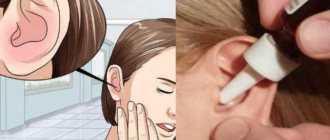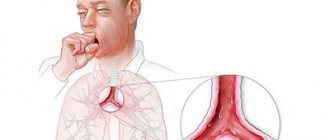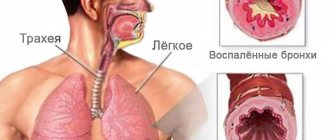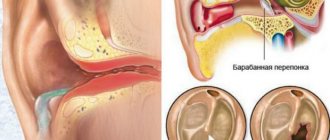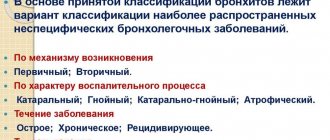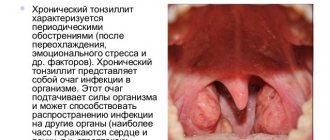Causes and mechanism of development
Inflammatory damage to the bronchi can be the primary site of infection, when the pathogenic process initially develops in the membranes of the bronchial tree.
Also, mucopurulent bronchitis can be a secondary disease that occurs against the background or as a result of other ailments. Often, bacterial damage to the bronchi is caused by pathologies of the upper respiratory tract: chronic sinusitis, tonsillitis, pharyngitis.
Infectious and non-infectious factors can give impetus to the development of mucopurulent bronchitis. Sources of pathogenic agents are endogenous and exogenous environments.
Non-infectious factors that can provoke mucopurulent lesions of the bronchi:
- household toxic substances in high doses;
- industrial air pollutants (dust, aerosols);
- unfavorable environmental conditions (presence of sulfur oxide, hydrogen sulfide, automobile exhausts in the atmosphere);
- smoke inhalation from active and passive smoking;
- unfavorable climatic and weather phenomena (sharp temperature changes, overheating or hypothermia of the body);
- unsatisfactory sanitary conditions in the home (dampness).
The above phenomena suppress local immunity and have an irritating and damaging effect on the epithelial lining of the bronchi. As a result, infectious agents easily penetrate into the respiratory system.
The direct cause of the increase in sputum secretion is the excessive activity of the glands of the trachea and bronchi in response to colonization of the respiratory tract by pathological microorganisms. The formation and discharge of mucopurulent sputum may indicate infection with bacteria and protozoa, such as:
- Pseudomonas aeruginosa (Pseudomonas aeruginosa);
- mycoplasma (Mycoplasma pneumoniae);
- chlamydia (Chlamydia pneumoniae);
- pneumococcus (Streptococcus pneumoniae);
- Staphylococcus aureus (Staphylococcus aureus);
- hemophilus influenzae (Haemophilus influenzae).
The chronic course of the disease in most cases is associated with the presence of untreated foci of infection in the tonsils, sinuses, and carious teeth. The provocateur of relapses is a decrease in local immunity as a result of acute respiratory viral diseases. Deterioration of local immune reactivity is associated with past “seasonal” diseases provoked by viruses:
- influenza (Influenza A, B);
- parainfluenza (Respirovirus);
- rhinovirus (Rhinovirus);
- adenovirus (Adenoviridae);
- respiratory syncytial virus (Human orthopneumovirus).
Attention! The chronic form of the disease can result from the use of incorrectly selected antibiotics, non-compliance with prescribed doses, or interruption of treatment before the end of the course.
With prolonged irritation of the bronchial tree, the secretory function of the trachea and large bronchi is activated. The secretion of inflamed fluid increases. The color, smell, consistency, transparency, and layering of the exudate change. Due to insufficient mucociliary clearance (mucociliary cleansing), the growth of bacterial flora increases. The sputum produced becomes mucopurulent.
Cough? Pay attention to the color of the sputum
Phlegm is mucus that is produced in the lungs and bronchial tree. It is known that sputum plays an important role in preventing the entry of microbes that can cause infection in the respiratory tract.
Changes in the color of sputum can provide a lot of information about what is happening to the respiratory system during colds and other illnesses. Below are the possible color options for sputum:
- sputum is normally transparent, liquid in consistency and released in small quantities. It consists of water, salts, and a small number of immune system cells. Sputum production is not normally felt by a person;
- The white color of sputum signals the occurrence of an inflammatory process in the respiratory tract. Initially, the mucous membrane swells, which slows down the passage of mucus through the respiratory tract. When this happens, the mucus becomes more viscous and turns white;
- yellow mucus means that an active immune response to an infection in the respiratory tract is beginning. Leukocytes, cells of the immune system, which are responsible for fighting bacterial infection, arrive at the site of inflammation;
- green sputum indicates a widespread and strong immune response. A mixture of a large number of leukocytes, bacteria and other cell components gives the mucus a green color;
- Red and brown sputum may indicate the presence of blood. Bleeding may be caused by small blood vessels in the respiratory system breaking during coughing. But often the presence of blood in the mucus, especially with heavy or prolonged bleeding, may indicate a severe disease. Bright red or pink sputum means the bleeding is recent, while brown mucus suggests more recent blood loss;
- A black tint of mucus may indicate the presence of a fungal infection in the respiratory tract and a weakened immune system. In this case, you should immediately consult a doctor.
Infection is not the only reason for changes in the consistency and color of sputum. The mucus may be thicker when you are dehydrated, after sleep, or after extreme stress. Allergic reactions can also change the color and texture of mucus.
The foamy structure of mucus indicates the presence of air bubbles in the sputum. Whitish-gray foamy mucus may be a sign of chronic obstructive pulmonary disease, and you should consult a doctor if you experience this symptom.
If the frothy sputum is pink in color and is also accompanied by difficulty breathing, increased sweating and chest pain, this may be a symptom of pulmonary edema and acute left-sided heart failure. This condition is life-threatening and in this case an ambulance should be called immediately.
It is important to remember that you cannot self-diagnose the disease based only on the color of the sputum. You should consult a specialist and conduct a comprehensive study of the bronchi and lungs
Therapeutic strategy
Without an integrated approach to the treatment of purulent inflammation of the bronchial mucosa, it will be incredibly difficult to cope with the problem. During the acute period of the disease, it is imperative to maintain bed rest, never smoke, and try to minimize the impact of negative factors affecting the functioning of the respiratory system. The patient needs hospitalization if bronchitis is accompanied by heart failure or severe symptoms of intoxication.
Traditional Treatments
The basis of therapy is the use of antibacterial drugs, since the doctor is faced with the task of ensuring the guaranteed death of the pathogenic microflora responsible for the accumulation of pus in the bronchi. Treatment is accompanied by a mandatory prescription of probiotics. For this purpose, the following groups of broad-spectrum antibiotics are used:
- Macrolides (Azithromycin, Clarithromycin). Penetrating into the bronchi, they inhibit protein synthesis in the cells of pathogenic bacteria, thereby reducing their ability to further reproduce.
- Aminopenicillins (Augomentin, Amoxiclav). Antibiotics from this group have a destructive effect on microbial tissue without causing harm to the human body.
- Cephalosporins (Ceftibuten, Cefaclor). Such drugs stop the synthesis of substances that form the basis of the membranes of pathogenic microorganisms.
- Fluoroquinolones (Levofloxacin, Ofloxacin). The active components of these drugs destroy the DNA of bacteria, which inevitably leads to their death.
To improve the evacuation of purulent secretions from the bronchi, the patient is prescribed mucolytic agents (Bromhexine, Mucaltin) and a course of medicinal inhalations. Sanitation bronchoscopy with bronchoalveolar lavage, local administration of antibiotics and secretoliths - all this contributes to the rapid relief of the purulent process in the bronchial tree.
Pathogenetic therapy is carried out simultaneously with taking multivitamin complexes and biostimulants. Breathing exercises and physical therapy bring tangible benefits. After acute symptoms subside, the patient is sent for physiotherapy (electrophoresis, UHF, microwave therapy) and chest massage. In the chronic course of the disease, the doctor may prescribe extracorporeal hemocorrection, a high-tech blood purification procedure.
Use of folk remedies
Often, in combination with generally accepted methods of treating bronchitis, recipes from traditional healers are used. The following natural remedies will help improve phlegm production and speed up the healing process:
- Garlic and onions. Place the chopped vegetables in a bowl and, leaning over it, inhale the vapors. In addition, you can get juice from a small head of onion, which should be taken three times a day for a week.
- Black radish and honey. It is necessary to cut out the middle of the root crop and fill it with beekeeping product. The medicinal mixture should be kept for several hours in a warm place. Take the resulting juice 3 teaspoons three times a day.
- Gastrointestinal fat. In the treatment of purulent bronchitis, badger, goose, goat and bear fats are used. Healing lard is either mixed with hot milk or a medicine is prepared based on it. To prepare the product, take 100 g of the main ingredient and the same amount of honey. Add a tablespoon of cocoa powder and aloe juice to the resulting thick mixture. Take the finished drug 10 g three times a day.
- Sea buckthorn. In the fight against bronchitis, jam made from the fruits of this small tree has proven itself well. At the first signs of illness, you need to include this tasty product in your diet.
- Elderflowers and ginger. When using a decoction based on these products, pus from the bronchi is disposed of much faster.
Treatment
Treatment procedures are most often performed on an outpatient basis. Placement of the patient in the pulmonology department is required in case of severe intoxication syndrome, respiratory failure, or suspicion of the development of complications.
The basic treatment for mucopurulent bronchitis is antibiotics. Most often, they resort to monotherapy with powerful antibacterial drugs of the latest generations. The patient may be prescribed injections or tablet forms of protected penicillins, macrolides, cephalosporins, and fluoroquinolones.
Important! Antibiotics are prescribed only by the attending physician based on laboratory data confirming the bacterial origin of the disease.
To liquefy mucus and stimulate its evacuation from the respiratory tract, mucolytic and expectorant agents are used. A good effect is demonstrated by inhalation. To normalize the temperature with a fever of more than 38.5°C, non-steroidal anti-inflammatory drugs are used. The presence of intoxication syndrome often requires drip administration of crystalloid plasma substitutes. To enhance the immune response, multivitamin complexes and biostimulants can be prescribed.
Drug treatment is combined with routine measures. Bed rest in the first days of illness, ensuring a comfortable room temperature, regular cross-ventilation, and air humidification will ensure a speedy recovery.
After the acute manifestations of mucopurulent bronchitis subside, the following will be beneficial: physical therapy, breathing exercises, and physical methods of therapy. Auxiliary measures in the treatment of the disease are folk remedies - herbal mixtures, rubbing and compresses.
What is the danger?
Since purulent is most often chronic bronchitis, which is protracted in nature, with frequent exacerbations, a constant increase in obstruction. In this case, there is a high risk of complications, for example, a purulent-obstructive appearance may develop. In people over 65 years of age, the likelihood of chronic obstruction increases.
She has the following symptoms:
- exhalation is prolonged, accompanied by a whistle;
- the lips are compressed when breathing, and the veins on the neck swell during exhalation;
- dry wheezing sounds are heard.
During periods of exacerbation, chronic purulent-obstructive bronchitis often leads to the development of acute respiratory failure. Other possible complications include:
- melting of the ciliated epithelium by pus and impaired sputum discharge;
- involvement of the walls of the bronchi in the process and pathological expansion of the bronchioles (bronchiectasis), as a result of which the vulnerability of the bronchi and lungs to infections increases, and a tendency to hemoptysis develops;
- spread of infection to the lungs, development of pneumonia.
Prognosis and prevention
The prognosis for mucopurulent bronchitis is often favorable. Complications arise from untimely initiation of treatment, non-compliance with medical recommendations, inadequate and incomplete therapy. Ignoring the symptoms of acute bronchitis often leads to chronicity of the process, the development of pneumonia, severe respiratory failure, pulmonary emphysema, and pulmonary hypertension.
Primary prevention measures: complete cessation of smoking, balanced diet, regular exposure to fresh air, physical activity. In case of frequent cases of respiratory diseases, it is recommended to refuse to work in professionally unfavorable conditions and change your place of residence to an environmentally friendly region.
Prevention methods
Symptoms of bronchitis
The main symptom of bronchitis is cough. The cough can be dry (without sputum) or wet (with sputum). The discharge of sputum, especially with a green tint, is a reliable criterion for bacterial inflammation. A dry cough can occur with a viral or atypical infection. The most common evolution of cough is from dry to wet. In acute illness, the cough is paroxysmal. in this case, coughing attacks can be so severe that they are accompanied by a headache.
Symptoms of acute bronchitis
Acute bronchitis is accompanied by a rise in temperature to 38-39 degrees, chills, and increased sweating. There is general weakness, fatigue and a significant decrease in performance. The severity of symptoms can range from moderate to very severe. When examining the patient, scattered wheezing, heard on auscultation, and harsh breathing are noticeable. With moderate or severe disease, the patient begins to suffer from shortness of breath and chest pain.
The average duration of acute bronchitis is 10-14 days. Exacerbation of chronic bronchitis, especially in the absence of adequate treatment, can last for weeks.
Symptoms of chronic bronchitis
In chronic bronchitis, cough with scanty sputum, shortness of breath during exercise can be constant symptoms that accompany the patient throughout life. In this case, an exacerbation of bronchitis is said to occur if there is a significant increase in the above symptoms: increased cough, increased volume of sputum, increased shortness of breath, the appearance of fever, etc.
Bronchitis, especially acute, rarely occurs in isolation. Most often it is combined with symptoms of rhinitis (runny nose), tracheitis. This certainly has an impact on the overall clinical picture.
Clinical symptoms
The main signs of infectious mucopurulent bronchitis are:
- severe intoxication syndrome;
- increased body temperature;
- cough;
- sputum discharge;
- in some cases - wheezing and shortness of breath.
Intoxication syndrome is associated with endogenous toxins - waste products of bacteria. The person indicates general weakness, decreased or lack of appetite, and poor health.
Important! The larger the focus of inflammation, the more severe the clinical manifestations of intoxication syndrome with mucopurulent bronchitis.
In the acute period of the disease, the temperature rises to 38.5°C. After 5-7 days, low-grade fever is observed. A rise in temperature is accompanied by increased sweating, chills and trembling.
The cough in the first days of the disease is dry (non-productive) and painful. Further cough:
- productive (wet)
- accompanied by pain in the chest area;
- overcomes constantly throughout the day;
- worsens when inhaling dry, cold air.
Sputum with mucopurulent bronchitis is homogeneous, viscous, cloudy. Pus is secreted or mixed with mucus, or is visible in the form of separate fragments. The color of the exudate is yellow or green. Usually sputum is odorless, but the secretion of mucopurulent bronchitis may have an unexpressed unpleasant odor.
In acute bronchitis, wheezing may be absent or sporadic. In the chronic form, wheezing is often heard, reminiscent of the sounds of bursting water bubbles. In the presence of thick secretions, buzzing, buzzing wheezing is heard. With a less dense exudate, pathological blistering noises are detected.
The patient experiences shortness of breath during physical exertion. If obstructive syndrome has developed, rapid and difficult breathing is constantly recorded. With bronchial obstruction, the process of removing secretions from the bronchi becomes difficult.
Traditional medicines
For any type of wet cough, including purulent, plenty of warm drinks are recommended: milk with honey, juices of radish, grapes, cranberries, herbal tea from raspberries, sage, linden blossom, chamomile, viburnum, plantain.
If you have a purulent cough, you should try to eat more vegetables and fruits rich in vitamins.
An effective remedy for purulent cough is badger and bear fat, which should be taken internally. Various steam inhalations with essential oils and garlic have a beneficial effect on the patient’s condition.
But folk remedies, after consultation with a doctor, can only be used as an auxiliary therapy. They are aimed at relieving the symptoms of a purulent cough and do not cure its root cause.
https://youtube.com/watch?v=FQbW-rswpOU
Treatment of urination when coughing.
Causes and treatment of dry cough in adults.
Symptoms and treatment of allergic cough.
What actions to take if your throat starts to feel sore.
Causes of pus
Purulent sputum is characterized by a certain color, which can be green, yellowish or brown. The exudate is characterized by a viscous structure and sometimes a specific, unpleasant odor.
The reasons for the appearance of pus in sputum may be:
- inflammation of the lungs and dysfunction;
- the appearance of malignant formations in the respiratory tract;
- tuberculosis, including the initial stage;
- bronchial asthma.
Less commonly, the cause of a cough with purulent sputum is a cold that has not been treated for a long time. This is another reason not to self-medicate and not to miss even the slightest symptoms of seasonal diseases.
Treatment of purulent bronchitis
To relieve painful symptoms before going to the doctor, it is recommended to drink expectorant syrups, hot milk with soda, inhale with mint or eucalyptus oil, and also lower the temperature with paracetamol. Under no circumstances should you delay a visit to the doctor (or calling him at home if you have a fever)!
Traditional treatment consists of taking antibiotics in the form of tablets and injections. Most often, doctors prescribe:
- hemomycin;
- rocephin;
- fortum.
If the cause of bronchitis is a virus, antiviral and immunomodulating agents are used:
- aflubin;
- kipferon;
- Viferon.
In combination with the above drugs, expectorants should be taken (orally or in the form of inhalation through a nebulizer):
- lazolvan;
- overslept;
- ambroxol.
To help bring down a high temperature:
- ibuprofen;
- panadol;
- paracetamol.
The treatment should definitely include inhalations with essential oils or in the form of a spray (Salamol), as well as mustard compresses. To speed up recovery, procedures such as UHF, electrophoresis, massage of affected organs, and therapeutic exercises are recommended.
Taking immunostimulants:
- immunoflasitis;
- immunorm;
- posterized
The patient should drink a lot: warm water, weak tea, maybe with the addition of lemon. Regular walks in the fresh air are very important, but hypothermia should be avoided.
It is also important to follow a diet. The diet should be rich in fatty foods; various meat broths are best
Fatty foods promote rapid mucus discharge. You should also add black radish and more honey to the menu.
Treatment with folk remedies
Inhalations shown:
- with garlic (immunostimulant plus antibacterial agent);
- with onions (antiviral agent);
- from onion skins.
Drinking medicinal decoctions and infusions:
- plantain decoction (expectorant);
- decoction of marshmallow and elecampane roots (expectorant);
- infusion or decoction of licorice root (immunostimulant).
Compresses:
- from potato peelings;
- from alcohol (for adults);
- from camphor oil;
- oil-garlic.
It is important to remember that folk remedies for bronchitis perfectly complement drug therapy prescribed by a doctor, but cannot completely replace it. Treatment of purulent bronchitis must be comprehensive, that is, none of the above methods should be neglected
Approximate diet and daily routine for a patient:
- On an empty stomach: a decoction of plantain plus an infusion of licorice root.
- Breakfast: chicken thigh broth, sausage sandwich, tea with honey.
- An hour later: a decoction of marshmallow and elecampane (or another), inhalation, compress.
- Lunch: meat borscht with garlic and butter, tea with honey and lemon.
- After an hour: take a decoction, inhalation, compress.
- Dinner: cottage cheese 9% fat with sour cream, semolina porridge with butter, tea with honey.
- Before going to bed: take decoctions, inhalation, compress.
Features of the treatment of purulent bronchitis in children
This form of bronchitis can affect not only adults, but also children. In this case, it is better to use only compresses from folk remedies (not all!) As for the rest of the treatment, you cannot do without a pediatrician, since:
- you need to choose the right dosage of antiviral drugs or antibiotics;
- not all immunostimulants are suitable for a child (they can often cause allergies);
- alcohol and mustard compresses are contraindicated for infants;
- inhalations with onions and garlic can cause crying and allergies in a child;
- expectorants and antiviral drugs should be selected by a doctor, taking into account contraindications and calculating the dose; This also applies to medications for fever.
Danger of pathology
Attention. Among all inflammatory diseases of the bronchial tree, purulent bronchitis is the most dangerous. As with any purulent inflammation, the infection can spread further throughout the body in several ways:
As with any purulent inflammation, the infection can spread further throughout the body in several ways:
- To continue. In this case, bronchogenic pneumonia occurs. Purulent inflammation of the lungs leads to rapid exhaustion of the body; foci of necrosis and islands of connective tissue proliferation can form in the lungs. In severe cases, pneumonia can be fatal or lead to lifelong respiratory failure.
- Lymphogenic. The infectious agent flows through the lymph into the lungs, mediastinal lymph nodes, and pleura. Purulent inflammation of the chest organs develops, which also significantly worsens the condition.
- Hematogenous. This is the most unfavorable option, in which bacteria are spread throughout the body by the bloodstream. This condition is called sepsis; it is dangerous due to the development of infectious-toxic shock and secondary infectious foci in various organs and tissues. These conditions are more common in children and people with weakened immune systems.
In addition to the spread of infection, purulent bronchitis is dangerous with a number of complications.
With purulent-obstructive bronchitis, respiratory failure develops due to narrowing of the lumen of the bronchial tree. The patient, weakened by the disease itself and the fight against bacterial infection, becomes difficult to breathe. Choking with obstructive bronchitis rarely occurs, but the patient’s quality of life is significantly reduced.
Chronic bronchitis itself is a complication. The transition of the disease to a chronic form indicates the lack of adequate treatment of acute pathology.
Attention! Chronic purulent bronchitis is dangerous because irreversible changes occur in the bronchi. The bronchial tree forever loses its original properties. In this case, the development of bronchiectasis, pulmonary emphysema and chronic obstructive disease is possible
It is impossible to cure these diseases; the patient is forced to take maintenance therapy all his life
In this case, the development of bronchiectasis, emphysema and chronic obstructive disease is possible. It is impossible to cure these diseases; the patient is forced to take maintenance therapy throughout his life.
Symptoms and signs
Symptoms of purulent bronchitis differ somewhat depending on the duration and form of the disease. In general, the following signs and manifestations are characteristic of the pathology in question:
- persistent cough;
- copious sputum production (up to 250 ml) of a purulent-mucous nature;
- development of shortness of breath;
- general weakness;
- increased sweating;
- asthenia;
- increased body temperature;
- chronic fatigue syndrome;
- pain in the chest area, occurring mainly during the coughing process;
- the appearance of bad breath;
- permanent lack of appetite;
- dulling of taste buds;
- chest myalgia;
- general intoxication of the body;
- tachycardia;
- pallor of the skin.
Another characteristic feature that allows one to identify purulent chronic bronchitis is a cough with purulent discharge, the duration of which exceeds a period of 3 months.
During an exacerbation of this disease, the patient experiences the following painful symptoms:
- fever;
- development of broncho-obstructive syndrome;
- difficulty breathing;
- increase in the size of the bronchi;
- the appearance of bloody streaks in the discharged purulent sputum;
- changes in blood composition, manifested in an increase in the number of neutrophils, leukocytes, as well as the level of ESR;
- the appearance of characteristic wheezing when breathing.
It should be emphasized that purulent bronchitis is a rather serious pathology, especially in the acute stage, it poses a potential danger not only to the health, but also to the life of the patient. Therefore, if you detect at least a few of the above signs, you should immediately seek medical help.
Purulent bronchitis has bright and unambiguous symptoms, the main of which are shortness of breath and pus that appears in the expectorated sputum.
If you observe such a picture in yourself or someone close to you, you should visit a qualified doctor as soon as possible. He will make an accurate diagnosis and prescribe treatment appropriate to the case.
Other symptoms of purulent bronchitis are:
- moist cough;
- body temperature 37-38 degrees;
- decreased performance;
- increased sweating.
In the most advanced cases, patients may experience obstruction or, in other words, disruption of the normal patency of the bronchi. This situation is caused by the accumulation of an excessive amount of mucous secretion. This pathological condition suggests that the patient has developed purulent obstructive chronic bronchitis.
If in this case you do not consult a doctor, then after a short period of time the patient will develop full-fledged pneumonia.
If you experience the symptoms described above, consult a doctor immediately. Additionally, read the article “Diagnostics for bronchitis.”
Diagnostics
Diagnosis is based on previous history, symptoms of sputum and instrumental studies, a general blood test, characterized by moderate leukocytosis, a shift of the leukocyte formula to the left, and an accelerated ESR.
X-ray examination for this bronchitis is not informative. Important diagnostic significance is given to the results of bronchoscopy. Using endoscopic diagnostics, swelling and hyperemia of the mucous membrane are detected, and accumulation of purulent secretion is noted in the bronchi.
Illustration of bronchoscopy
The bronchoscopy procedure is complemented by a biopsy (sampling of the contents of the bronchi) for further cytological and bacteriological conclusions.
Diagnosis of chronic purulent bronchitis is carried out on the basis of a thorough analysis of the general clinical picture and the results of the anamnesis, in addition, during a physical examination. However, given the fact that the pathology in question does not have pronounced, specific symptoms, and its symptoms are quite typical for a number of other diseases of the respiratory system, then to establish an accurate diagnosis, the patient is prescribed the following studies:
- general and biochemical blood test;
- fluorographic examination;
- X-ray of the chest area;
- bronchoscopy;
- study of bronchial patency;
- sputum analysis;
- bronchography;
- computed tomography of the chest;
- conducting serological tests;
- bacterial and microscopic examination of sputum;
- ultrasonography.
After diagnosis, identification of the form and etiology of the disease, you can proceed to the immediate treatment process.
As soon as the first symptoms appear, especially in those patients who suffer from chronic bronchitis, a comprehensive study will help establish a final diagnosis.
Sometimes it is possible to identify a purulent inflammatory process with fluorography.
Laboratory tests can determine whether there are bacteria in the sputum.
- microscopic;
- biochemistry;
- cytological.
A blood test will show moderate leukocytosis, a slight acceleration of ESR.
Hyper-a1- and a2-globulinemia, an increase in the amount of seromucoid and sialic acids are detected in the blood serum.
X-ray of the lungs for such a disease is considered not as informative, unlike bronchoscopy.
During such a study, signs of hyperemia, swelling of the mucous membrane, and a large amount of pus in the bronchi are detected.
During bronchoscopy, secretions are necessarily taken for examination in order to identify the pathogen and determine its susceptibility to antibacterial drugs.
If these studies are not enough, the doctor may prescribe additional examination methods - ultrasound, which will help exclude cancer. Once the diagnosis has been clarified, treatment can be prescribed.
It is very important to conduct additional examination in situations where there are symptoms indicating the presence of pus.
Such bronchitis can often be confused with pneumonia, tuberculosis or cancer.
When carrying out differential diagnosis, the nature of the cough and the contents of purulent compartments are taken into account.
It is imperative to undergo a complete examination of the entire body to exclude other pathologies, because some pathologies can develop asymptomatically.
The purulent form of bronchitis differs from bronchial asthma in the absence of suffocation. There are also no allergic manifestations.
The most important thing is to recognize oncology against the background of purulent bronchitis.
Blood and chest pain are suspicious symptoms in this case.
To refute suspicions, it is necessary to urgently undergo an X-ray examination, tomography and bronchography.
Answers to frequently asked questions on the topic of acute and chronic bronchitis:
How effective is breathing exercises for bronchitis? Breathing exercises, for example, according to the Strelnikova or Buteyko method, is an essential component of treatment, especially for chronic bronchitis.
I suspect that I have allergic bronchitis. Is this possible? There is no such diagnosis as allergic bronchitis. It is possible to develop an infectious disease against the background of bronchial asthma. In this case, allergic inflammation and the infectious process seem to “support” each other. In any case, it is necessary to consult an allergist and conduct a full allergological examination (skin tests, blood tests to identify specific antibodies to allergens, etc.).
What diseases can chronic bronchitis be confused with? The list of diseases accompanied by a lingering cough is quite long. First of all, differential diagnosis is carried out between tuberculosis, chronic obstructive pulmonary disease (COPD), bronchiectasis, asthma, and cancer.
Treatment of chronic bronchitis
Exacerbation of chronic bronchitis is treated inpatiently, under the supervision of a pulmonologist. In this case, the basic principles of treatment of acute bronchitis are observed. It is important to avoid contact with toxic factors (tobacco smoke, harmful substances, etc.).
Pharmacotherapy of chronic bronchitis includes the prescription of antimicrobial, mucolytic, bronchodilator, and immunomodulatory drugs. For antibacterial therapy, penicillins, macrolides, cephalosporins, fluoroquinolones, tetracyclines are used orally, parenterally or endobronchially. For difficult to separate viscous sputum, mucolytic and expectorant agents (ambroxol, acetylcysteine, etc.) are used. In order to relieve bronchospasm in chronic bronchitis, bronchodilators (aminophylline, theophylline, salbutamol) are indicated. It is mandatory to take immunoregulatory agents (levamisole, methyluracil, etc.).
In case of severe chronic bronchitis, therapeutic (sanitation) bronchoscopy and bronchoalveolar lavage can be performed. To restore the drainage function of the bronchi, auxiliary therapy methods are used: alkaline and medicinal inhalations, postural drainage, chest massage (vibration, percussion), breathing exercises, physiotherapy (UHF and electrophoresis on the chest, diathermy), speleotherapy. Outside of exacerbation, it is recommended to stay in sanatoriums on the southern coast of Crimea.
For chronic bronchitis complicated by pulmonary heart failure, oxygen therapy, cardiac glycosides, diuretics, and anticoagulants are indicated.
Purulent bronchitis: causes, symptoms, diagnosis and treatment
Purulent bronchitis is an inflammatory process of the upper respiratory tract, which affects the bronchi. The production and secretion of mucopurulent or purulent secretion occurs. The etiology of the disease is caused by an infectious agent. The main complaint is a cough with purulent sputum. Patients also complain of fever, shortness of breath, and intoxication of the body.
The diagnosis is established after examining the patient, determining the symptoms and clinical picture, studying a chest x-ray, and microscopic examination of sputum. Purulent bronchitis in adults and children can be treated with antibiotics, physiotherapeutic procedures, and expectorants.
Symptoms
A patient’s “acquaintance” with catarrhal or purulent bronchitis begins after a cold, hypothermia, an episode of allergies, or due to reinfection from a chronic focus. The preceding clinical manifestations are rhinitis and tracheitis. This is explained by the descending development of the disease.
The basic syndrome of purulent bronchitis is intoxication of the body, accompanied by shortness of breath, hacking cough with the release of yellow or green purulent sputum.
There is weakness, lethargy, sweating, and a gradual increase in body temperature to 37.2–38 ºC. The chronic version of the course is characterized by episodic expectoration.
Due to severe weakness and shortness of breath, patients are advised to avoid physical activity.
Note: Hemoptysis is a rare symptom. Doctors explain it as an injury to the mucous membrane of the respiratory tract.
If purulent bronchitis drags on, obstruction may develop. In this case, an obstructive form of bronchitis occurs. Shortness of breath noticeably increases, whistling appears when breathing, patients complain of difficult coughing up mucus. The course of the disease worsens, and there is a risk of developing pulmonary emphysema and complications of the cardiovascular system.
Folk remedies
Traditional medicine helps traditional methods speed up treatment. At the same time, doctors recommend normalizing the diet and enriching the food range with meat and fish broths.
Among the recipes, badger fat is noted, which is mixed with boiled milk in the proportion of one tablespoon of fat per glass of milk. To improve the taste, honey or cocoa is added to milk. You need to take the mixture twice a day, one glass.
Helpful tip: If you find it difficult to drink this, spread the fat on bread and eat the resulting “sandwich.”
Rubbing with animal fat before bed helps well in treatment. The areas for the procedure are the chest and back, while it is better to bypass the projection of the heart. After rubbing, the patient is put to bed, wrapped in a towel or cellophane with a warm sheet.
Don't forget about the accompanying natural remedies with antibacterial properties. Compared to medications, the effect of natural “healers” is softer, more gentle, and does not disturb the intestinal microflora. Prominent representatives of natural “doctors” are onions, garlic, cranberries, and ginger root.
Complications
The most dangerous complication of the disease is pneumonia, which develops with improper treatment of bronchitis. There is also swelling of the mucous membrane of the respiratory tract, which leads to changes and atrophy of the epithelial layer. This is fraught with deterioration in the drainage properties of the bronchopulmonary system.
Other complications are possible:
- allergy;
- bronchial asthma;
- dissemination of infection;
- development of pneumosclerosis;
- bronchiectasis;
- respiratory failure;
- chronicity of the process, especially with an obstructive component;
- formation of the pulmonary heart with subsequent symptoms of circulatory failure.
